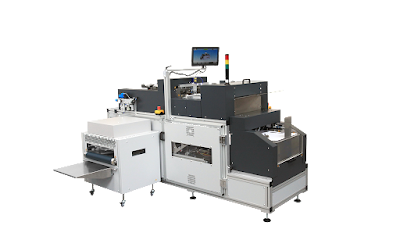 |
| Image from Burleson Public Library |
The first thing you see when you pick up a book is the cover. However, it is the inside of the book, the book block, which has a far greater impact on the overall functionality of the book. In this post, we are going to cover three book block construction methods and their advantages and disadvantages.
Layflat binding is a premium quality technique which is used for books with a strong visual impact. The most common applications are photo books, children's books and sales collateral for high end real estate and yachts. A layflat book consists of series of panoramic two-page spreads without any gutter or break in the center.
 |
| Image from Imaging Solutions AG |
Layflat books are manufactured by printing each two page spread, leaving the back of each printed sheet blank. The printed sheets are creased and folded at the center then glued together back-to-back or with a cardboard sheet sandwiched between to create thicker pages.
 |
| fastBook Professional by Imaging Solutions AG |
Most personalized layflat books are made using equipment from Imaging Solutions AG in Switzerland. The fastBlock and fastBook Professional take the printed and collated sheets and do the creasing, folding and gluing to create a book block ready for trimming.
While layflat books have strong visual impact and are extremely durable, they require twice as much paper as other types of books and the binding process is slower because each page is glued individually. They are too expensive for most mainstream book projects.
Most library books and textbooks are bound using Smyth Sewing. A Smyth sewn book is manufactured by printing the content on both sides of a large sheet. These sheets are folded to create signatures consisting of multiple pages, often 16 or 24 pages per signature. Each signature is sewn with thread through multiple places along the spine of the book. Then all of the signatures are sewn together to create the complete book block.
 |
| Smyth Machinery USA Provides equipment for Smyth Sewing |
Automated equipment for building Smyth sewn books was first patented by David McConnell Smyth in 1871 and the company which bears his name is still one of the leading suppliers of Smyth sewing equipment. Because the threads go through every page, these books are durable and hold up well to heavy use. However, the process works best for large runs of books and is seldom used for personalized book projects.
The most popular from of book binding is perfect binding which is used for almost all paperback books and many inexpensive hard cover books. In a perfect bound book, the pages are printed on both sides and trimmed to a single page size. The pages are collated together and the spinal edge is roughed up with blades or abrasives. Next an EVA (Ethylene Vinyl Acetate) hotmelt glue is applied to the spine and the spine of the book block is pressed into the spine of the soft cover. As the glue cools, it holds the pages together and holds the cover to the book block.
If the perfect bound block is to be used in a hardback book, stronger end papers are added at the front and back of the book before it is glued. These will be used to attach the book block to the cover.
 |
| A perfect binding machine from Standard Horizon. |
Many companies make perfect binding equipment including Standard Horizon, Mueller Martini and CP Bourg.
Perfect bound books are popular because they are lightweight and inexpensive to make. However, the glue in the spines keeps the books from opening flat. If the books are forced open, the spine can be broken and the pages can fall out. Heavy use can also cause the spines to give way and allow the pages to fall out. While this binding method is often used for personalized books, the books lack the durability and the visual impact of layflat books.
There is a variation of perfect binding called PUR binding. With PUR, the EVA hotmelt adhesive is replaced with a Polyurethane Reactive adhesive. This is stronger and makes the pages less likely to fall out, but it also requires several hours of curing time before the book can be trimmed. This makes it less attractive for manufacturing personalized books.
Whichever of these binding methods are used, the final book block must be trimmed on the top, bottom and front edge before it can be cased in.
You might also like:

No comments:
Post a Comment